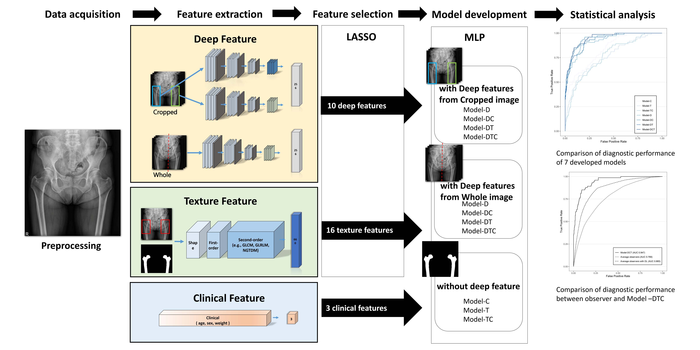
Flow diagram for feature selection and deep-radiomics model development. LASSO = least absolute shrinkage and selection operator, MLP = multilayer perceptron, Model-C = model with clinical features, Model-T = model with texture features, Model-TC = model with texture and clinical features, Model-D = model with deep features, Model-DC = model with deep and clinical features, Model-DT = model with deep and texture features, Model-DTC = model with deep, clinical, and texture features. Image courtesy of the Radiological Society of North America
May 25, 2022 — A new method that combines imaging information with artificial intelligence (AI) can diagnose osteoporosis from hip X-rays, according to a study in Radiology: Artificial Intelligence. Researchers said the approach could help speed treatment to patients before fractures occur.
People with osteoporosis, a skeletal disease that thins and weakens bones, are susceptible to fracture associated with bone fragility, resulting in poor quality of life and increased mortality. According to statistics from the International Osteoporosis Foundation, one in three women worldwide over the age of 50 years and one in five men will experience osteoporotic fractures in their lifetime.
Early screening for osteoporosis with dual-energy X-ray absorptiometry (DXA) to assess bone mineral density is an important tool for timely treatment that can reduce the risk of fractures. However, the low availability of the scanners and the relatively high cost has limited its use for screening and post-treatment follow-up.
In contrast, plain X-ray is widely available and is used frequently for various clinical indications in daily practice. Despite these attributes, it has been relatively underutilized in the management of osteoporosis because diagnosing osteoporosis using only X-rays is challenging even for an experienced radiologist.
“For patients with hip pain, radiologists often evaluate only image findings that may cause pain, such as fractures, osteonecrosis and osteoarthritis,” said study author Hee-Dong Chae, M.D., from the Department of Radiology at Seoul National University Hospital in Seoul, Korea. “Although X-ray images contain more information about the healthiness of the patient’s bones and muscles, this information is often overlooked or considered less important.”
Dr. Chae and colleagues developed a model that can automatically diagnose osteoporosis from hip X-rays. The method combines radiomics, a series of image processing and analysis methods to obtain information from the image, with deep learning, an advanced type of AI. Deep learning can be trained to find patterns in images associated with disease.
The researchers developed the deep-radiomics model using almost 5,000 hip X-rays from 4,308 patients obtained over more than 10 years. They developed the models with a variety of deep, clinical and texture features and then tested them externally on 444 hip X-rays from another institution.
The deep-radiomics model with deep, clinical, and texture features was able to diagnose osteoporosis on hip X-rays with superior diagnostic performance than the models using either texture or deep features alone, enabling opportunistic diagnosis of osteoporosis.
“Our study shows that opportunistic detection of osteoporosis using these X-ray images is advantageous, and our model can serve as a triage tool recommending DXA in patients with highly suspected osteoporosis,” Dr. Chae said.
The researchers are planning a larger study that combines the clinical information from Korea’s National Health Insurance Service database with the imaging data of the Seoul University Hospital.
For more information: www.rsna.org


 December 24, 2025
December 24, 2025 









